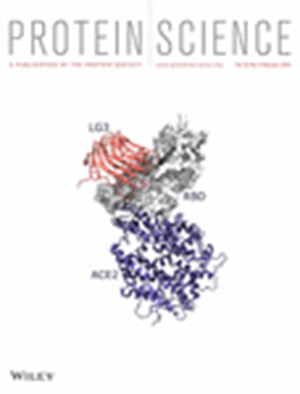Disentangling the formation, mechanism, and evolvement of the covalent methanesulfonyl fluoride acetylcholinesterase adduct: Insights into an aged‐like inactive complex susceptible to reactivation by a combination of nucleophiles
IF 4.5
3区 生物学
Q1 BIOCHEMISTRY & MOLECULAR BIOLOGY
引用次数: 0
Abstract
Chemical warfare nerve agents and pesticides, known as organophosphorus compounds inactivate cholinesterases (ChEs) by phosphorylating the serine hydroxyl group located at the active site of ChEs. Over the course of time, phosphorylation is followed by loss of an organophosphate‐leaving group and the bond with ChEs becomes irreversible, a process known as aging. Differently, structurally related irreversible catalytic poisons bearing sulfur instead of phosphorus convert ChEs in its aged form only by covalently binding to the key catalytic serine. Kinetic and crystallographic studies of the interaction between解密共价甲磺酰氟乙酰胆碱酯酶加合物的形成、机制和演变:揭示易被多种亲核物重新激活的老化型非活性复合物
化学战中的神经毒剂和杀虫剂(即有机磷化合物)通过使位于胆碱酯酶活性位点的丝氨酸羟基磷酸化而使胆碱酯酶(ChEs)失活。随着时间的推移,磷酸化后会失去一个离开有机磷的基团,与胆碱酯酶的结合变得不可逆,这一过程被称为老化。与此不同的是,结构上相关的不可逆催化毒药以硫代磷,只有通过与关键的催化丝氨酸共价结合,才能将 ChEs 转变为老化形式。对鱼雷乙酰胆碱酯酶(TcAChE)与一种小型有机磺酸盐--甲磺酰氟(MSF)--之间相互作用的动力学和晶体学研究显示,不可逆的甲磺酰化丝氨酸 200 与结合的老化沙林/沙曼类似物具有同工性。在 MSF-酶加合物晶体结构的活性位点上,强效大分子可逆抑制剂 7-双他克林(BTA)的位置和方向与 BTA-酶复合物晶体结构中的位置和方向非常相似。值得注意的是,BTA 的存在使甲烷磺酰化的速度加快了两倍。这一出乎意料的结果可以用两个事实来解释:i) BTA 对 MSF 进入活性位点产生的立体阻碍;ii) MSF-酶加合物形成的加速度,是催化丝氨酸附近旋转和平移自由度降低的结果。众所周知,单独使用或在底物乙酰胆碱存在的情况下,普拉唑肟(2-吡啶醛肟氯甲烷,2-PAM)不能重新激活 TcAChE-MSF 加合物的活性位点丝氨酸。我们的研究表明,2-PAM 和额外的中性肟--2-[(羟基亚氨基)甲基]-l-甲基咪唑(2-HAM)同时存在时,可在一小时内触发 TcAChE 的再活化过程。总之,我们的研究结果为可能使用独特的鸡尾酒肟作为有效、快速重新激活老化胆碱酯酶的配方铺平了道路。
本文章由计算机程序翻译,如有差异,请以英文原文为准。
求助全文
约1分钟内获得全文
求助全文
来源期刊

Protein Science
生物-生化与分子生物学
CiteScore
12.40
自引率
1.20%
发文量
246
审稿时长
1 months
期刊介绍:
Protein Science, the flagship journal of The Protein Society, is a publication that focuses on advancing fundamental knowledge in the field of protein molecules. The journal welcomes original reports and review articles that contribute to our understanding of protein function, structure, folding, design, and evolution.
Additionally, Protein Science encourages papers that explore the applications of protein science in various areas such as therapeutics, protein-based biomaterials, bionanotechnology, synthetic biology, and bioelectronics.
The journal accepts manuscript submissions in any suitable format for review, with the requirement of converting the manuscript to journal-style format only upon acceptance for publication.
Protein Science is indexed and abstracted in numerous databases, including the Agricultural & Environmental Science Database (ProQuest), Biological Science Database (ProQuest), CAS: Chemical Abstracts Service (ACS), Embase (Elsevier), Health & Medical Collection (ProQuest), Health Research Premium Collection (ProQuest), Materials Science & Engineering Database (ProQuest), MEDLINE/PubMed (NLM), Natural Science Collection (ProQuest), and SciTech Premium Collection (ProQuest).
 求助内容:
求助内容: 应助结果提醒方式:
应助结果提醒方式:


